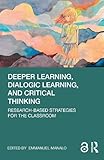Deeper learning, dialogic learning, and critical thinking : research-based strategies for the classroom / edited by Emmanuel Manalo
Material type: TextPublisher: Milton : Routledge, 2020Copyright date: ©2020Description: 1 online resource (xxii, 363 pages) : illustrationsContent type:
TextPublisher: Milton : Routledge, 2020Copyright date: ©2020Description: 1 online resource (xxii, 363 pages) : illustrationsContent type: - text
- computer
- online resource
- 9781000617443
- 1000617440
- 9780429323058
- 0429323050
- 9781000627428
- 100062742X
- 9781000622430
- 1000622436
- Learning strategies -- Study and teaching
- Critical thinking -- Study and teaching
- Communication in education
- Educational innovations
- EDUCATION -- Professional Development
- EDUCATION -- Teaching Methods & Materials -- General
- Communication in education
- Critical thinking -- Study and teaching
- Educational innovations
- Learning strategies -- Study and teaching
- 370.1523 23
Deeper learning, dialogic learning, and critical thinking are essential capabilities in the 21st-century environments we now operate. Apart from being important in themselves, they are also crucial in enabling the acquisition of many other 21st-century skills/capabilities such as problem solving, collaborative learning, innovation, information and media literacy, and so on. However, the majority of teachers in schools and instructors in higher education are inadequately prepared for the task of promoting deeper learning, dialogic learning, and critical thinking in their students. This is despite the fact that there are educational researchers who are developing and evaluating strategies for such promotion. The problem is bridging the gap between the educational researchers' work and what gets conveyed to teachers and instructors as evidence-based, usable strategies. This book addresses that gap: in it, leading scholars from around the world describe strategies they have developed for successfully cultivating students' capabilities for deeper learning and transfer of what they learn, dialogic learning and effective communication, and critical thought. They explore connections in the promotion of these capabilities, and they provide, in accessible form, research evidence demonstrating the efficacy of the strategies. They also discuss answers to the questions of how and why the strategies work. A seminal resource, this book creates tangible links between innovative educational research and classroom teaching practices to address the all-important question of how we can realize our ideals for education in the 21st century. It is a must read for pre-service and in-service teachers, teacher educators and professional developers, and educational researchers who truly care that we deliver education that will prepare and serve students for life
Includes bibliographical references and index
The playground of ideas: developing a structured approach to the community of inquiry for young children / Laura Kerslake -- The Thinking Together approach to dialogic teaching / Neil Phillipson and Rupert Wegerif -- Compare and discuss to promote deeper learning / Bethany Rittle-Johnson, Jon R. Star, Kelley Durkin, and Abbey Loehr -- Refining student thinking through scientific theory building / Hillary Swanson -- Extending students' communicative repertoires: a culture of inquiry perspective for reflexive learning / Beth V. Yeager, Maria Lucia Castanheira, and Judith Green -- Transforming classroom discourse as a resource for learning: adapting interactional ethnography for teaching and learning / W. Douglas Baker -- Question Based Instruction (QBI) promotes learners' abilities to ask more questions and express opinions during group discussions / Yoshinori Oyama and Tomoko Yagahashi -- AugmentedWorld: a location-based question-generating platform as a means of promoting 21st-century skills / Shadi Asakle and Miri Barak -- Effective ways to prepare for deeper learning of history / Keita Shinogaya -- "Laughter is the best medicine": pedagogies of humor and joy that support critical thinking and communicative competence / Jean J. Ryoo -- Improving college students' critical thinking through the use of a story tool for self-regulated learning training / Pedro Rosâario, Josâe Carlos Nâuänez, Paula Magalhaes, Sonia Fuentes, Cleidilene Magalhaes, and Kyle Busing -- Debugging as a context for fostering reflection on critical thinking and emotion / David LeLiema, Maggie Dahn, Virginia J. Flood, Ana Asuncion, Dor Abrahamson, Noel Enyedy, and Francis Steen -- Showing what it looks like: teaching students to use diagrams in problem solving, communication, and thinking / Emmanuel Manalo, Yuri Uesaka, Ouhao Chen, and Hiroaki Ayabe -- Class design for developing presentation skills for graduate research students / Etsuko Tanaka and Emmanuel Manalo -- Online written argumentation: internal dialogic features and classroom instruction / Naomi Rosedale, Stuart McNaughton, Rebecca Jesson, Tong Zhu, and Jacinta Oldehaver -- Cultivating pre-service and in-service teachers' abilities to deepen understanding and promote learning strategy use in pupils / Tatsushi Fukaya and Yuri Uesaka -- Cultivation of a critical thinking disposition and inquiry skills among high school students / Takashi Kusumi -- Using task-based language teaching in the second language classroom: developing global communication competencies / Chris Sheppard -- Collective reasoning in elementary engineering education / Christine M. Cunningham and Gregory J. Kelly
Emmanuel Manalo is a professor at the Graduate School of Education of Kyoto University in Japan. He teaches educational psychology and academic communication skills to undergraduate and graduate students. His research interests include the promotion of effective learning and instructional strategies; diagram use for communication, problem solving, and thinking; and critical and other thinking skills.
Description based on print version record
Added to collection customer.56279.3

There are no comments on this title.